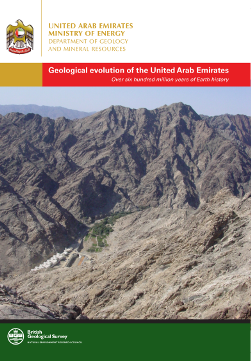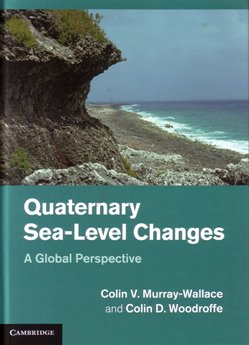
Geology and Geophysics of the United Arab Emirates
These 12 volumes and the accompanying maps with descriptions produced by the BGS for the UAE Ministry of Energy provide a comprehensive and up-to-date account of the geology, geophysics, resources and geological hazards of the UAE.
Three volumes are likely to be of interest to the general reader: one on the geology and evolution of the western part of the Hajar mountains (V2), and another on the geology and evolution of the mainly island salt-plugs (V7). The third (V6) contains a description of the subsurface geology and that of the overlying Tertiary rocks, so well exposed in west of the UAE. There is a detailed description of the extensive inland cover of dune-sand and the deposits of the barrier-islands, lagoons and coastal plain. This includes a discussion of their contentious Quaternary evolution (see Stevens et al., 2014) using abundant OSL and U-Pb zircon dates.
The availability and future potential of various economic deposits, excluding oil, is discussed in vols. 3, 9, 10 and 11. The limestone resources, particularly dimension stone (widely used but mainly imported - V11), building aggregate, armour stone for harbour and coastal defences, rock wool and rock for tile manufacture as well as other construction materials are also considered (V10). Surprisingly, there is a lack of high quality silica-sand in this desert area due to impurities and unsuitable grain size of the dune-sand.
The occurrence of various economic mineral deposits (copper, chromite, platinum minerals etc.) in the ophiolitic rocks of the Hajar mountains are described (Vs 3,8) although these are not thought to be economic at present. There is a review of the hydrogeology (V3) although this is relatively unimportant, except in local areas of agriculture, as the major part of the water consumed is produced by desalination of seawater.
The geohazards of the region are discussed in V4 including the plate-tectonic setting of the surrounding area and its history of its seismic tremors and tsunamis. It is concluded that the UAE is a low risk area. The other geohazards of the mountain front (rock falls, rock slides); alluvial fans (mainly flash-floods); the desert (dust and blown sand) as well as those of the coastal plain (aggressive ground water, liquefaction and variable strengths of sediments) are also considered.
Surprisingly there is no discussion of likely future problems posed by sea-level rise in a country whose major developments occur on a low coastal plain only a few metres above high water mark.
Various volumes (Vs 1, 5 & 12) of appendices and of executive summaries and others give further details of the geology and geophysics of particular areas and the sedimentology and palaeontology of some of the rocks of the Hajar mountains.
The volumes are all beautifully illustrated with abundant figures and photographs and a useful bibliography. The series will undoubtedly be extremely useful to geologists, engineers and planners.
- Reference: Stevens, T., Jestico, M.J., Evans, G., Kirkham, A., 2014. Eustatic control of late Quaternary sea-level change in the Arabian/Persian Gulf. Quaternary Research 82, 175-184
Reviewed by Graham Evans
THE GEOLOGY AND GEOPHYSICS OF THE UNITED ARAB EMIRATES: (12 Volumes by various authors and of various dates 2006 - 2012). Ministry of Energy, United Arab Emirates. For prices see W: http://www.bgs.ac.uk/research/international/UAE.html
 Mining in Cornwall and Devon - Mines and Men
Mining in Cornwall and Devon - Mines and Men
This work is the result of over 40 years’ research into mine production data from the mines of Cornwall and Devon. Mostly gained form Parliamentary Papers and other official nineteenth century sources. The task of gathering the data was first started in the mid-1970s using the technology of the time to sort and store the vast amounts of information. With state-of-the-art technology now available, a decision was made to publish this information.
At first, offering the data on-line was considered - but the route eventually chosen was to introduce the subject with a book accompanied by a CD of all the data to date. The book contains over 70 pages of tabulated figures in addition to the data that can be accessed on the CD. The statistics date from 1790 to the present day and have been gathered from some very obscure sources. The information presented not only details what the mines produced, who owned and managed them but also how many men, women and children were employed.
Not surprisingly, most data relates to metalliferous mining, but stone and clay quarrying and coal mining are also included. A useful section is the inclusion of biographical notes relating to Mine Managers, in addition to a bibliography of mine-related books and articles. The latter is not comprehensive but gives the researcher a starting-point for further investigations. The book is illustrated with 15 photographs, mostly relatively modern. These break up the text, but their quality is not as high as some other books on mining in the south west – possibly because of the quality of paper used.
There are some useful appendices such as the financial state of the mines over time and the costs of materials and labour in relation to them and in particular the section relating to mining companies and their personnel. The biographical details relating to mine managers will be of interest to historians. The final section of the book relates to the CD and is in effect a ‘user manual’.
This book will probably become a standard reference for the economic and social history of the mines of Cornwall and Devon, as a supplement to already-published works that relate to the geological and technical aspects of this fascinating area of study.
Reviewed by Richard Porter
MINING IN CORNWALL AND DEVON: MINES AND MEN by BURT R, with BURNLEY R, GILL M and NEILL A. 2014 Published by University of Exeter Press. ISBN 978 0 85989 889 8. 251pp. List Price £25.00
 Quaternary Sea-Level Changes
Quaternary Sea-Level Changes
Sea-levels have changed substantially over the last two million years on both a global and a local scale, and now global warming predicts that there are likely to be significant rises in the relatively near future. Flooding caused by such changes has the potential to directly affect the lives of more than one billion people in coastal areas worldwide and with more people moving to coastal cities the situation is only going to get worse. An understanding of both the natural and anthropogenic processes that cause such changes is important in refining these predictions so that appropriate action may be taken.
Sea-levels can change by a number of different factors: the volume of water in the oceans can alter; or its temperature can rise or fall causing expansion or contraction; or there can be a change in level of the land caused by isostasy, or volcanic, seismic and tectonic forces. It’s all relative! As geologists we know that such changes have been going on throughout the history of planet Earth although until the application of scientific principles such phenomena were given mythological or religious explanations.
This review by two Australian academics into the history of research on a world-wide basis summarises the analytical methods used to interpret the variety of evidence about sea-level changes. It covers the early examples that were explained in terms of the anger of the gods and then logically and symptomatically covers the evolution of ideas that has generated our present understanding. There are also 78 pages of references - a truly magnificent collection for those engaged in research in this area!
Over the past two or three decades a series of threats to life on Earth has been revealed, showing that we do not live in a stable unchanging situation with perhaps sea-level rise being one of the most important, with its implications for moving populations and for food and water resources. There seem to be two main problems; first, there is not full agreement between scientists working in this field, particularly on the amount and timing of the changes; and second, the political systems in at least the democratic countries of the world are predicated on both short-term actions and national interest to win votes. It is hoped that this well written and readable textbook will help make a significant contribution by advancing knowledge - or am I being too optimistic?
Reviewed by Rick Brassington
QUATERNARY SEA-LEVEL CHANGES: A GLOBAL PERSPECTIVE by COLIN V. MURRAY-WALLACE & COLIN D. WOODROFFE 2014. Published by: Cambridge University Press 484 pp (hbk) ISBN: 978-0-521-82083-7. List price: £80.00 (US$ 125.00) www.cambridge.org
 A Photographic Guide to Shetland's Geology
A Photographic Guide to Shetland's Geology
This book is intended for the non-specialist visitor to Shetland who wishes to learn something of the geology of the archipelago. Following a basic introduction and summary of Shetland’s plate tectonic history there is a brief comment on Geopark Shetland which has developed an ingenious app linked to GPS to provide visitors with geological information on their mobiles when they arrive at a location of interest.
The core of the book is divided into sections based on rock types each accompanied by illustrative photographs. There is a section on the Shetland ophiolite, one on landscape, another on rocks, minerals and man and a final section unimaginatively labelled miscellaneous rocks, which deals with diagenesis, weathering and the colouration of rocks by algae and lichens. There is a two page glossary of geological terms, and maps showing the location of the photographs.
So, does the book fulfil its stated purpose? Only partly, I think. A field trip guide might have been a better approach. Many of the colour photographs are very good, particularly those showing cliff sections, but there are too many photographs of beach boulders and pebbles which frankly are rather unappealing. The captions are generally clear, concise, informative and entertaining.
The problem is how the visitor is expected to use this book. It is all very well to illustrate the difference between a basalt and an andesite, but to see them both the visitor might have to trek for miles. I suspect that the authors had in mind the casual visitor walking along a beach and finding an interesting-looking rock which he wants to identify, in which case the book would probably be helpful.
Shetland has some stunning coastal scenery and one might reasonably expect to see photographs of some of the best examples, rather than pictures of a gravelly bank which opens the landscape section, or four pages showing rocks covered with algae and lichen, or of one showing the difference between wet and dry pebbles. A few well-chosen aerial views would have been preferable.
On the whole a rather disappointing book, at a rather inflated price, but which includes a contribution to Geopark Shetland. I suspect one might do better to download the app, and use that.
Reviewed by Don Hallett
A PHOTOGRAPHIC GUIDE TO SHETLAND’S GEOLOGY by DAVID MALCOLM and ROBINA R BARTON, 2015. Published by: The Shetland Times Ltd, 118pp (sbk) ISBN: 978-1-904746-97-3. List price £15.99. W: www.shetlandtimes.co.uk.